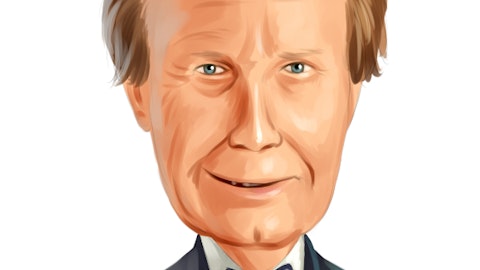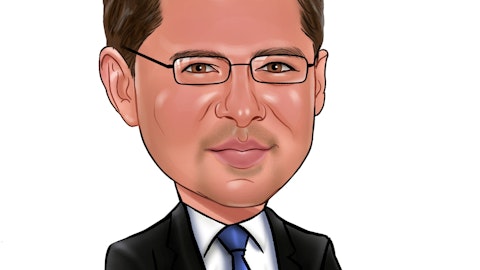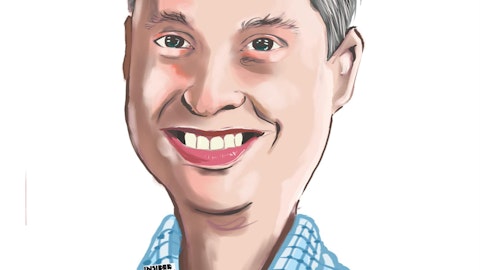Grosvenor Capital Management, L.P. (NASDAQ:GCMG) Q1 2023 Earnings Call Transcript May 15, 2023
Operator: Welcome to the GCM Grosvenor 2023 First Quarter Results Call. [Operator Instructions] As a reminder, this call can be recorded. I would now like to hand the call over to Stacie Selinger, Head Investor – Head of Investor Relations. You may begin.
Stacie Selinger: Thank you. Good morning, and welcome to GCM Grosvenor’s first quarter 2023 earnings call. Today, I am joined by GCM Grosvenor’s Chairman and Chief Executive Officer, Michael Sacks; President, Jon Levin; and Chief Financial Officer, Pam Bentley. Before we discuss this quarter’s results, a reminder that all statements made on this call that do not relate to matters of historical facts should be considered forward-looking statements. This includes statements regarding our current expectations for the business, our financial performance and projections. These statements are neither promises nor guarantees. They involve known and unknown risks, uncertainties and other important factors that may cause our actual results to differ materially from those indicated by the forward-looking statements on this call.
Please refer to the factors in the Risk Factors section of our 10-K, our other filings with the Securities and Exchange Commission and our earnings release, all of which are available on the Public Shareholders section of our website. We’ll also refer to non-GAAP measures that we view as important in assessing the performance of our business. A reconciliation of non-GAAP metrics to the nearest GAAP metric can be found in our earnings presentation and earnings supplement, both of which are available on the Public Shareholders section of our website. Our goal is to continually improve how we communicate with and engage with our shareholders. And in that spirit, we look forward to your feedback. Thank you again for joining us. And with that, I’ll turn the call over to Michael.
Michael Sacks: Thank you, Stacy. The first quarter of 2023 marked the fourth consecutive year with significant first quarter volatility and market dislocation. From COVID to meme stocks, the war in Ukraine, the Silicon Valley Bank and Credit Suisse, the first quarter of each of the last 4 years has been tough for investors. Through each of these periods, GCM Grosvenor has enjoyed relative stability in our portfolios for clients and in our business for team members and shareholders. The strength of the alternative asset management strategies generally and the strength of GCM Grosvenor’s broad-based, diversified solutions approach specifically shines during volatile times. As such, our confidence in the value proposition we bring to clients, and in the value of our firm for shareholders remains strong.
In the first quarter, we performed in line with the guidance we provided on our last earnings call. We raised just under $1 billion in a tough fundraising environment. Importantly, our private markets verticals continue to grow at double-digit top line rates, with private markets management fees, excluding catch-up fees, growing 13% year-over-year. Private market strategies now comprise roughly 70% of our total AUM. Due to the impact of 2022 on absolute return strategy fee-paying AUM, overall fee-related revenue was roughly flat in Q1 compared to a year ago. As we expected, fee-related earnings and fee-related earnings margins were both slightly lower than a year ago. Our recent ARS performance has been competitive with regard to peers and relevant industries, and delivered the best first quarter we’ve had in some time.
Capital markets and transaction activity levels continue to be depressed, which we believe is a significant driver of the overall alternative space right now. In the first quarter, less than 1% of our beginning quarter private markets fee-paying AUM was distributed to clients. That compares to an average of almost twice that rate for the previous 9 quarters. As a result, incentive fees were low, which was an important factor in year-over-year adjusted EBITDA and adjusted net income levels. Across the industry, the low levels of transaction activity result in less capital being returned to LPs. That’s putting pressure on investor liquidity and slows the timing of new commitments. We believe the flywheel will improve when transaction levels pick back up.
Looking forward, for the second quarter, we anticipate private markets management fees, excluding catch-up fees, will grow in the high single digits year-over-year. And absolute return strategies management fees will be roughly flat compared to Q1 ‘23. The result will be a Q2 FRE that’s pretty similar to Q1 ‘23. For the full year compared to 2022, we continue to expect double-digit fee-related earnings growth with expanded FRE margins. While sales cycles have been stretched somewhat, our fundraising pipeline remains strong. As we saw in ‘22 and ‘21, we expect back half fundraising will exceed first half fundraising this year. Our unrealized carry continues to represent significant upside to recent revenue levels although we make no prediction as to the timing of realizations.
We remain set up well for the intermediate and long term. For 2024, we continue to see solid double-digit fee-related earnings growth on reasonable fundraising assumptions with some continued FRE margin expansion. Perhaps more than anything, we’re excited about deploying our approximately $10 billion of dry powder in what we believe will be a more advantageous investment environment than we have seen in a while. Although the macro environment remains challenging, we feel fortunate that we enjoy great client relationships, are adding value to client portfolios, are growing, generating cash, paying a healthy, safe dividend and buying back shares. It’s a pretty good picture in a tough environment, and it’s a direct result of the efforts our team and our broadly diversified client-first solutions approach bring.

Research, Investment, Finance
We have a strong business with significant opportunity and upside, and we look forward to generating returns for all of our constituents going forward. And with that, I’ll turn it over to Jon.
Jon Levin: Thank you, Michael. I will spend a few minutes going into a bit more detail on our capital formation results and strategy. The breadth, depth and flexibility of our platform enables us to credibly compete for nearly any mandate available to an alternative solutions provider, which makes for a very large total addressable market. As Michael noted, the environment at this particular moment in time is challenging, but we do not see the secular tailwinds behind long-term demand for alternatives abating. If anything, the relative outperformance of alternatives compared to other asset classes has only heightened long-term investor demand. In fact, mature investors to alternatives are employing creative and flexible strategies around their target asset allocations to ensure that they are able to continue deploying capital in this market.
History has proven that remaining committed to a programmatic approach to alternative investing adds value over time. In addition, there continues to be an attractive opportunity set to grow with newer allocators to alternatives, such as insurance companies and retail investors. Against that backdrop, we continue to be bullish on the long-term demand for alternatives. Now to our fundraising. Over the last 2 years, our fundraising has been characterized by 3 main themes: first, the double mix shift in our business toward private markets and fee-accretive strategies; second, the success with which we’ve expanded our existing client relationships into new areas; and third, increasing momentum in new geographies and channels where we’ve made investments.
We have talked about the double mix shift on many of these calls, but it’s one of the most important things to understand about our business. 87% of the capital that we’ve raised over the last 2 years was for private markets. And of that, 50% was raised in fee-accretive strategies, which we define as co-investments, direct investments and secondaries. This has had a material impact on our business composition. As of the end of the first quarter, private markets now comprises approximately 70% of our total AUM, which is a significant increase from 59% of our total AUM at the end of 2020. Within private markets, infrastructure has been the most significant growth driver. Over the last 2 years, we’ve raised more than $5 billion for infrastructure programs as investors continue to appreciate the strategy of cash yield generation, long-dated capital appreciation and inflation protection.
Our significant and broad experience in the infrastructure space positions us well to pick up further market share in this area. Turning to the second driver of our fundraising, we have very successfully expanded our existing client relationships through re-ups and extending those relationships into new strategies. Over the past 2 years, 21% of our fundraising has been cross-selling to our existing clients. Approximately 50% of our top 50 clients work with us in multiple strategies and approximately one-third of our top 50 clients have programs in both absolute return strategies and private markets. Interestingly, while the majority of our fundraising over the past few years has typically come from our existing clients, 63% of our first quarter fundraising came from new clients, which brings me to the third fundraising driver.
As you know, we’ve been investing in new channels and geographies over the past few years, which we believe will drive significant future growth. Most recently, we announced the opening of a new office in Sydney, Australia. While it takes time for any new efforts to scale and reach their full potential, we’re encouraged by the early signs of the investments that we’ve been making. Similarly, over the last few years, the insurance in non-institutional or retail channels began to demonstrate their potential as strong contributors to fundraising. Nearly 20% of our flows over the last 2 years came from these channels combined, and given each represent very large total addressable markets, we expect these channels to be meaningful contributors to our fundraising going forward.
Our deep and broad manufacturing platform, strong existing client relationships and focus on growing channels provide us with ample opportunities to deliver stability and growth as we move forward. With that, I’ll turn the call over to Pam.
Pam Bentley: Thanks, Jon. We are well positioned as a management fee-driven, balance sheet-light business, and our strength, stability and scalability have continued to serve us well amidst challenging markets. Assets under management increased to $75 billion in the quarter, a 5% increase from a year ago and a 2% increase from the fourth quarter. Fee-paying AUM increased 3% from a year ago and 2% from the fourth quarter. Private markets continue to be the primary driver of fee-paying AUM growth, increasing 12% from a year ago from a combination of fundraising and deployment. Nearly $1 billion of contracted, not yet fee-paying AUM became fee paying in the quarter. Although fee-related revenue was effectively flat on a year-over-year basis, private markets management fees experienced healthy growth of 11% year-over-year, which was offset by ‘22 market impacts on absolute return strategies management fees.
Excluding catch-up fees, private markets management fees increased 13% from the first quarter of ‘22, which was on the high end of our guidance. In the second quarter, we anticipate modest specialized fund closings, and we do not expect any material catch-up fees. Therefore, second quarter private markets management fees, absent catch-up fees, are expected to grow in the high single digits as compared to the same quarter a year ago. As we foreshadowed on our last call, absolute return strategies management fees declined slightly this quarter versus the fourth quarter of ‘22. Given absolute return strategies fee-paying AUM was relatively flat in Q1, we expect second quarter ARS management fees to be roughly the same as this quarter. We realized $5.8 million of incentive fees in Q1, the majority from carried interest.
As Michael mentioned, the realization environment continues to be challenging, and until market inflation and interest rates settle out, M&A volume is likely to be muted. That said, our carried interest earnings power continues to improve. As of quarter end, we have $804 million in growth unrealized carried interest across 135 programs, the firm share of which is $376 million. The firm share of unrealized carry has been steadily increasing. And when transaction volumes return, we believe carry will contribute meaningfully to our earnings. Our annual performance fees are tied to absolute return strategies investment returns and typically crystallize in the fourth quarter each year. Given the impact of ‘22 performance on high watermarks, combined with solid performance in Q1, our ‘23 performance fee earnings potential is approximately $16 million, assuming an annualized 8% gross rate of return for multi-strategy and 10% growth rate of return for opportunistic investments for the remainder of ‘23.
This compares to $29 million of performance fee earnings potential if all portfolios were at high watermark. Turning to our expenses, our compensation strategy is rooted in fostering alignment between our employees, clients and shareholders. Fee-related earnings compensation in the quarter was approximately $40 million, down slightly compared to the first quarter of ‘22. As a reminder, FRE compensation is typically elevated in the first quarter, so we do expect it to marginally decline in subsequent quarters. As we disclosed last quarter, in ‘22, we granted 4.5 million restricted shares to employees, of which 3.2 million vested in the first quarter, resulting in stock compensation expense of $26 million. Importantly, we have and will continue to buy back shares to minimize dilution from stock-based compensation.
This quarter, we repurchased approximately 2.9 million shares or $23 million of stock, and have approximately $23 million remaining in our stock buyback authorization, which we continue to put to work. We expect stock compensation expense in the second quarter to return to normalized levels coming in below what we saw in the fourth quarter of last year. As expected, non-GAAP general administrative and other expenses increased sequentially from the fourth quarter to $19.7 million. We continue to tightly manage expenses despite inflationary pressures and expect this figure to remain stable in the second quarter. From a capitalization standpoint, we continue to be balance-sheet light, and our cash generation is comfortably in excess of our current dividend.
As we have said in the past, we anticipate growing our dividend over time as our fee-related earnings increase. To that point, I will end by reiterating our confidence in achieving our long-term growth objectives. We remain focused on unlocking the full potential embedded in our platform to generate long-term value for our clients and shareholders. Thank you again for joining us, and we’re now happy to take your questions.
See also 12 Best Household and Personal Care Stocks To Buy and States With the Lowest to Highest Capital Gains Tax Rate.
Q&A Session
Follow Gcm Grosvenor Inc.
Follow Gcm Grosvenor Inc.
Operator: [Operator Instructions] And we’ll now take our first question from Bill Katz from Credit Suisse.
Operator: Thank you. We will take our next question from Chris Kotowski from Oppenheimer. Please go ahead.
Operator: Thank you. We will take our next question from Adam Beatty from UBS.
Operator: Thank you. We will next go to Kenneth Worthington from JPMorgan. Please go ahead.
Operator: Thank you. [Operator Instructions] we will take our next question from Michael Cyprys from Morgan Stanley.
Operator: Thank you. We will take our next question from Jeff Schmitt from William Blair.
Operator: Thank you. And I’m not showing any further questions.
Stacie Selinger: Well, thank you again for joining us today. We welcome your follow-up questions, and we look forward to speaking with you again next quarter.
Michael Sacks: Thank you.
Operator: Thank you, ladies and gentlemen, and thank you for participating in today’s conference. This concludes today’s program. We hope everyone has a great day. You may all disconnect.





